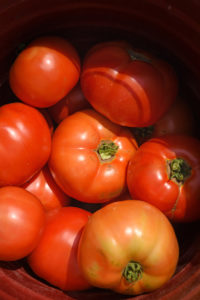Tomato Problems Related to High Heat
go.ncsu.edu/readext?714847
en Español / em Português
El inglés es el idioma de control de esta página. En la medida en que haya algún conflicto entre la traducción al inglés y la traducción, el inglés prevalece.
Al hacer clic en el enlace de traducción se activa un servicio de traducción gratuito para convertir la página al español. Al igual que con cualquier traducción por Internet, la conversión no es sensible al contexto y puede que no traduzca el texto en su significado original. NC State Extension no garantiza la exactitud del texto traducido. Por favor, tenga en cuenta que algunas aplicaciones y/o servicios pueden no funcionar como se espera cuando se traducen.
Português
Inglês é o idioma de controle desta página. Na medida que haja algum conflito entre o texto original em Inglês e a tradução, o Inglês prevalece.
Ao clicar no link de tradução, um serviço gratuito de tradução será ativado para converter a página para o Português. Como em qualquer tradução pela internet, a conversão não é sensivel ao contexto e pode não ocorrer a tradução para o significado orginal. O serviço de Extensão da Carolina do Norte (NC State Extension) não garante a exatidão do texto traduzido. Por favor, observe que algumas funções ou serviços podem não funcionar como esperado após a tradução.
English
English is the controlling language of this page. To the extent there is any conflict between the English text and the translation, English controls.
Clicking on the translation link activates a free translation service to convert the page to Spanish. As with any Internet translation, the conversion is not context-sensitive and may not translate the text to its original meaning. NC State Extension does not guarantee the accuracy of the translated text. Please note that some applications and/or services may not function as expected when translated.
Collapse ▲When we have high temperatures we can experience problems with vegetable fruit set and quality. Tomatoes are one of the most common plants that we get questions about in the Extension Office.
Daytime temperatures over 90° F and night temperatures over 70° F reduce fruit set in tomatoes. Flowers die and drop due to a lack of pollination or the pollen not being viable.
Another problem with tomatoes during high temperatures is internal white tissue. The white tissue is only noticeable when the fruit is cut. The hard, white areas tend to be in the outer walls of the fruit, although it can also appear in the center of the fruit. High temperatures during the ripening period seem to trigger the symptoms. The darker red varieties are more resistant to this problem.
Blossom end rot is a common problem on tomatoes related to calcium deficiency in the developing fruit. It is most often related to feast and famine when it comes to soil moisture. Blossom end rot is worsened by dry soils that don’t allow the calcium that is present in the soil to be in the soil solution and to be taken up by plant roots. Using an organic mulch can help keep the soil from becoming overly dry and help to reduce the incidence of blossom end rot.
As always, and especially during hot temperatures when you irrigate, make sure the garden soil is wetted to a depth of 6-8 inches. Poke a long-handled screwdriver into the soil until it becomes hard to push. Remove it from the soil and you can measure how deep the soil is wetted. With experience, you will know how long it takes to water your soil to the desired depth, once the top of the soil starts drying out.





